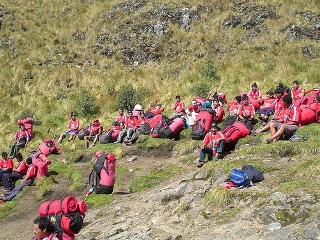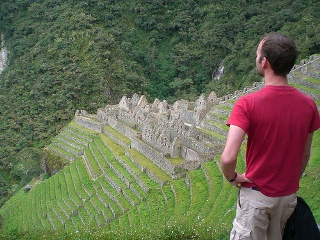I think I can reasonably say that, after having walked over miles of pavement in various cities over the past year, we are in fairly good shape. Not marathon-good or anything but better shape than we were when we owned a car and were travelling only to work and back. However, we are milquetoasts compared to the strength and stamina of the porters on the Inca trail.
The tour company we went with, Llama Path, was recommended to us by friends and has a mandate of sustainable tourism. I understand that this means they strive to be friendly to the environment and fair to their staff. Before the labour laws came into being several years ago, it wasn’t uncommon for porters to carry 60kgs. of weight over the rough and high trail of 45kms, to find/bring their own food and to secure their own shelter, which meant sleeping on the bare ground inside a natural cave. This is almost unbelieveable but we were assured of its truth by those who had been working the trail for years. At any rate, things are miles better now with regulated pay, hours, treatment and a maximum carry-weight of 25kgs.
 For our group of 11 clients, there were 2 guides, 1 cook and 16 porters. They carried everything we would need for our trip, less the sleeping bag and sleeping mats that we carried ourselves. I was struggling with a little over 7kgs. in my pack so I find it remarkable that the porters carrying the propane tank, or the folding tables, or the cook stove were breezing past me at a steady pace. That work is some Jesus hard. (Marc is hidden somewhere in this picture of our porters in their uniforms during a rarely seen break.)
For our group of 11 clients, there were 2 guides, 1 cook and 16 porters. They carried everything we would need for our trip, less the sleeping bag and sleeping mats that we carried ourselves. I was struggling with a little over 7kgs. in my pack so I find it remarkable that the porters carrying the propane tank, or the folding tables, or the cook stove were breezing past me at a steady pace. That work is some Jesus hard. (Marc is hidden somewhere in this picture of our porters in their uniforms during a rarely seen break.)
 At any rate, we were regularly rewarded during our trek with some excellent opportunities to explore various Inca ruins. I think my favourite is Winay Wayna, a small city perched on the very edge of a mountain-top near Machu Picchu. The theory is that it was used mainly an agricultural establishment which provided much of the food needed at MP. The terraces, the water management system, and the remaining buildings are fantastic feats of architecture- it was just fascinating to me to see how they had built a city and a farm on the side of steep, unforgiving mountain.
At any rate, we were regularly rewarded during our trek with some excellent opportunities to explore various Inca ruins. I think my favourite is Winay Wayna, a small city perched on the very edge of a mountain-top near Machu Picchu. The theory is that it was used mainly an agricultural establishment which provided much of the food needed at MP. The terraces, the water management system, and the remaining buildings are fantastic feats of architecture- it was just fascinating to me to see how they had built a city and a farm on the side of steep, unforgiving mountain.
Our guide explained that in the Inca culture, there were three ways the people got work done: 1 – “you scratch my back and I’ll scratch yours”, a way of one person helping his neighbour with a big chore and then having the neighbour return the favour; 2 – “all in” where every member of the community must be present to assist with a large task that benefits the community, or else pay a fine; 3 – “labour taxes”, one member of each family must pay taxes in the form of 3 months’ labour for public services, like building irragation systems, repairing buildings, constructing terraces, etc. Clearly, the Incas got alot done during their reign and I have to wonder: did the average person have more respect for public property because he/she was a part of its construction and/or maintenance?